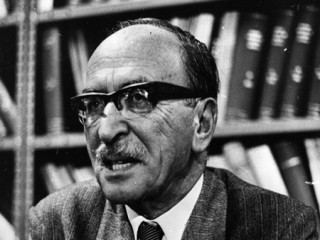
Dennis Gabor biography
Date of birth : 1900-06-05
Date of death : 1979-02-08
Birthplace : Budapest, Hungary
Nationality : Hungarian-British
Category : Arhitecture and Engineering
Last modified : 2011-02-18
Credited as : Physicist, and electrical engineer, inventing holography
The Hungarian-British physicist Dennis Gabor received the Nobel Prize in Physics in 1971 for his invention of holographic photography.
Dennis Gabor was born on June 5, 1900, in Budapest, Hungary, to S. Berthold and Ady (Jacobovits) Gabor. The son of a businessman, he received his education at the technical universities of Budapest (1918-1920) and Berlin (1920-1927). He earned both his diploma and his doctorate in engineering from the Technische Hochschule, in Charlottenburg, Germany, the former in 1924, the latter in 1927. He remained in Berlin upon graduation, working as a research engineer for Siemens and Halske until Hitler's rise to power in 1933. At that point he left Germany for Britain, taking a job with the British Thomson-Houston Company in Rugby, England.
Gabor stayed with the British firm for 15 years, from 1933 to 1948, working on the improvement of the resolving power of the electron microscope. The electron microscope had increased resolving power a hundredfold over the finest light microscopes, yet it still fell short of allowing scientists to "see" atomic lattices (the patterned arrangement of atoms, not individual atoms, which are too small). The image was distorted in two ways—fuzziness (as if one's camera were out of focus) and sphericity (as though one were looking through a raindrop). If one improved the former, the latter worsened, and vice-versa.
In 1947 a brilliant solution occurred to Gabor. What if one were to use the diffraction pattern (the fuzziness) in a way which provided one with all the information about the atomic lattice. That is, why not take an unclear electron picture, then clarify that picture by optical means. This was the genesis of holography. Gabor proposed to take an electron beam of light and split it in two, sending one beam to an object, the other to a mirror. Both would initially have the same wavelength and be in phase (coherent), but upon reflection from the object and the mirror back to the photographic plate, interference would be set up. Imagine ocean waves rolling in upon a long, sandy beach, one following another. Imagine them all equal in size, intensity, and timing. Now imagine you could split the beach in two, with two sets of waves coming in upon two different beaches. Tilt these two at an angle of your own choosing, superimpose them, and imagine the interference the waves would create for each other. This interference would not be completely chaotic, but would actually follow a pattern. From this "diffraction" pattern, one could reconstruct the initial waves. Now vary these initial waves in size, intensity, and timing (which might be imagined as due to different weather conditions out at sea). The diffraction pattern would differ correspondingly, and even the weather conditions might be hypothetically reconstructed. This is what Gabor wished to do with electron beams. The beam from the mirror would be unchanged, but the beam reflected from the object would contain all the irregularities imposed upon it by that object. Upon their meeting at the photographic plate, the two beams would be generally incoherent, and an interference pattern would occur. This interference could then be captured upon film, and if light were then shone through this film, it would take on the interference pattern and produce an image capable of three-dimensional reconstruction.
Gabor worked out the basic technique by using conventional, filtered light sources, not electron beams. The mercury lamp and pinhole were utilized to form the first, imprecise holograms. But because even this light was too diffuse, holography did not become commercially feasible until 1960, with the development of the laser, which amplifies the intensity of light waves. Nevertheless, Gabor demonstrated mathematically that holography would work even with electron beams—just as his experiments showed it worked with ordinary light. The major practical problem remaining with the electron microscope prior to 1960, however, was not left unchallenged by Gabor—this was the double image incidentally obtained by the holographic process. Gabor was able to use the very defect of electron lenses—spherical aberration—to remove the second image.
Gabor published the principle of holography and the results of his experiments in Nature (1948), Proceedings of the Royal Society (1949), and Proceedings of the Physical Society (1951). This work earned him in 1948 a position on the staff of the Imperial College of Science and Technology, London. In 1958 he was promoted to professor of applied electron physics, and he held that post until his retirement in 1967. His other work consisted of research on high-speed oscilloscopes, communication theory, physical optics, and television, and he was awarded more than 100 patents. Yet Gabor was not the pure scientist or isolated inventor; many of his popular works addressed the social implications of technological advance, and he remained suspicious of assumptions of inevitable technological progress, nothing the social problems it could not solve as well as the ones it caused.
Gabor received many honors. In 1956 he was nominated to the Royal Society; he was made an honorary member of the Hungarian Academy of Scientists; and in 1971 he received the Nobel Physics Prize for his holographic work. He died in London on February 8, 1979.
















